Bradan WTW (2019)
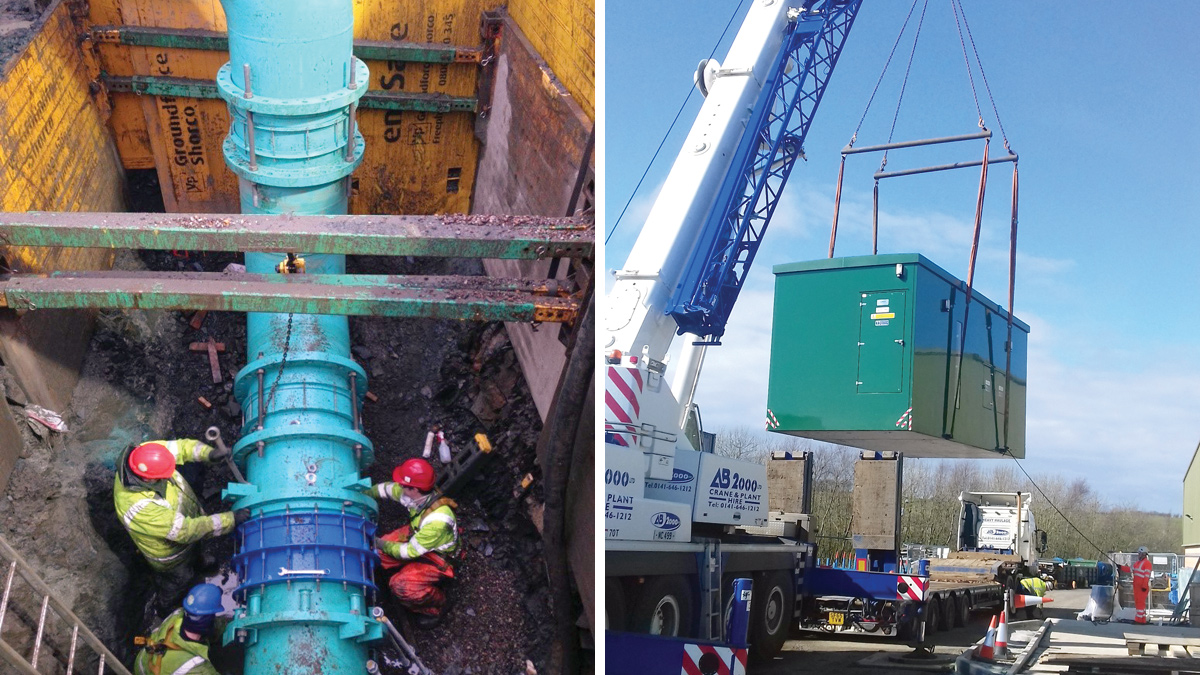
(left) Installation of static mixers at Bradan WTW and (right) Installation of chemical dosing kiosk at Ashgrove - Courtesy of ESD
Located in South Ayrshire, Scotland, Bradan Water Treatment Works (WTW) has a capacity of 120 Ml/day, with an output of approximately 70 Ml/day. The existing treatment processes comprise aluminium sulphate coagulation, dissolved air flotation, primary filtration, manganese contactors, orthophosphate dosing, lime and disinfection. The works supplies a large area along the west coast of Scotland, the size of the area means treated water may spend significant time in the distribution network and due to the area, which it serves, the time in distribution can be significant. The design-build project is being delivered by ESD; a Galliford Try, MWH Treatment and Binnies Joint Venture formed to manage, design and deliver Scottish Water’s Q&SIV Non-Infrastructure Programme.
Background
Bradan WTW has had a history of seasonal trihalomethane (THM) failures in distribution due to the presence of natural organic matter in the final water. Secondary chlorination is undertaken in the distribution system at several service reservoirs.
This was needed to maintain chlorine residual values but further contributed to THM formation and the risk of failure.
To provide regional resilience, the distribution system served by Bradan is also linked to the Afton supply area. The Bradan catchment is also linked to a distribution zone to the north of the region supplied by Camphill WTW at Ashgrove Clear Water Tank (CWT), which has a 5 Ml capacity and is located next to a mothballed WTW at Saltcoats.
Afton WTW treats raw water abstracted from the adjacent Afton Reservoir to supply the local distribution system via on site service reservoirs. The works has a conventional 3-stage process employing aluminium sulphate coagulation, clarification, rapid gravity primary filters, manganese contactors and disinfection. It is rated at 25 Ml/day and normally works at 16 or 17 Ml/day.
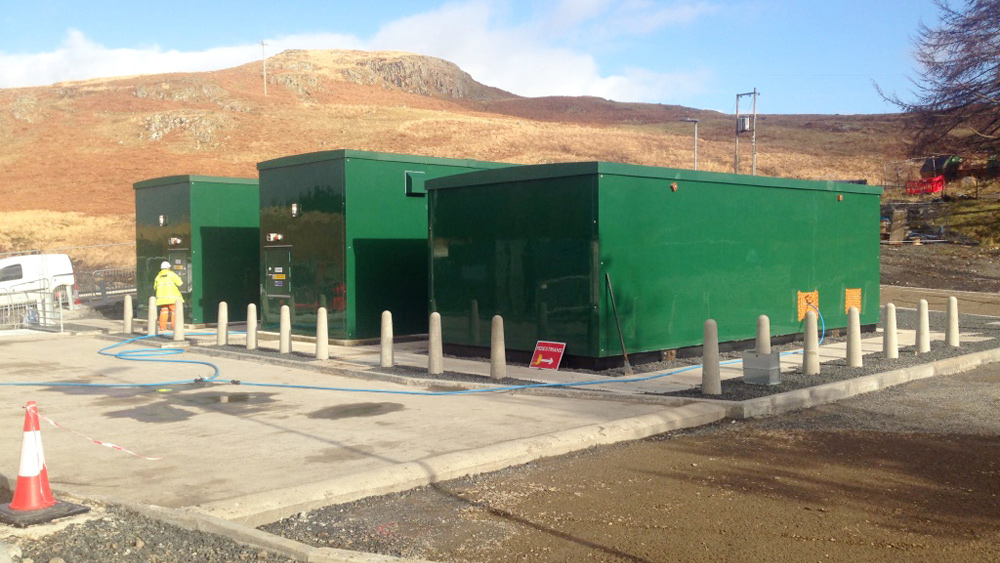
Chemical dosing kiosks at Bradan WTW – Courtesy of ESD
The scheme
Because of the THM failures, Scottish Water had an undertaking to implement a solution. The solution adopted was to install chloramination to ‘freeze’ the THM concentrations at Bradan WTW at the value that the WTW process currently provides. Chloramination prevents prescribed concentration or value (PVC) failures at the customers tap. During chloramination, both chlorine and small amounts of ammonia are added to the water, one at a time, which react together to form chloramine (also called combined chlorine), a long-lasting disinfectant.
In addition to addressing the problem at Bradan WTW, Scottish Water has also made the strategic plan to implement chloramination at Afton WTW. In this way, the current resilience in the supply network can be maintained which minimises the risk of taste and odour issues if chlorinated and chloraminated waters from the adjoining catchments mixed.
It was also decided as part of the scheme to introduce chloramination at Ashgrove CWT to provide the facility to import chloraminated water from the Camphill supply zone to the Bradan supply zone. This would allow Ardrossan/Saltcoats and local areas to be supplied from Camphill WTW, via Giffordland Service Reservoir (SR), should there be a failure in supply or distribution in the Bradan supply area.
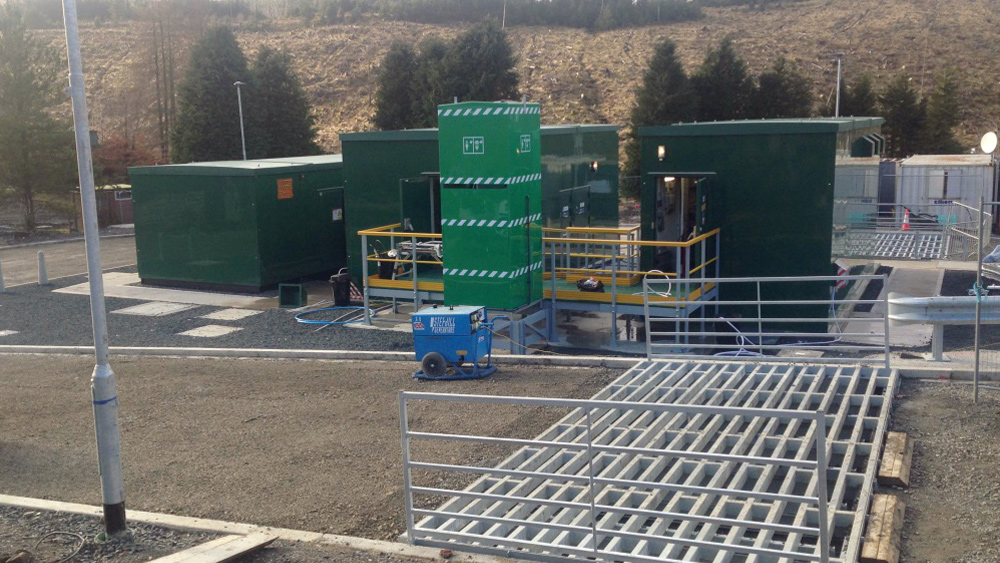
Chemical dosing kiosks at Bradan WTW – Courtesy of ESD
Works at Bradan WTW
At the end of the water treatment process at Bradan there is a twin compartment clear water tank. Each compartment has independent outlet pipes which combine before water is fee into distribution.
A new ammonium sulphate storage and dosing plant has been provided to treat up to design flow of 120 Ml/day. The chemical dosing systems are based on a standard product design and were manufactured off site and delivered pretested onto a flat slab. A chemical off-loading hard standing area was provided with a chemical interceptor tank to protect the surface water system from contamination.
To introduce the ammonium sulphate, new static mixers have been inserted in each of the outlet pipes. An additional cross connection pipe between the outlet pipes has been provided before the chemical dosing to provide additional flexibility if one of the clear water tank compartments is taken out of service for maintenance.
Duty/standby-free chlorine monitors have been installed upstream of the new dosing points and an ammonia monitor downstream of the new ammonium sulphate dose point on each CWT outlet. New final water free chlorine and total chlorine is monitored after the ammonium sulphate is dosed in the static mixer.
The existing flow meters on each of the CWT outlet pipes have been retained and their signals have been integrated into the control system. The existing chlorine in the water leaving the contact tank is controlled to the required residual value before the ammonium sulphate is added to maintain the correct levels of chloramine in the distribution network.
The works were undertaken in a phased manner to avoid loss of supply from the WTW.
Bradan WTW – Water Quality Scheme: Key participants
- Client: Scottish Water
- Principal contractor/designer: ESD JV
- Chemical skid subcontractor: IDSystems
- Mechanical installation: Dustacco Engineering
- Civil pipeline subcontractor: Coffey Construction
- Miscellaneous civil works: ESD
Works at Afton WTW
A new ammonium sulphate storage and dosing plant has been provided to treat up to design flow of 25 Ml/day. This introduces chloramination between the contact tank and clear water tanks before going into distribution. Like Bradan, the dosing system is based on a standard design fabricated off-site and delivered fully tested. A chemical off-loading hard standing area was provided utilising an existing chemical interceptor tank.
The ammonium sulphate is dosed into a new static mixer that was installed to replace an existing mixer to improve the efficiency of the mixing.
Duty/standby free chlorine monitors have been installed upstream of the new dosing point and an ammonia monitor downstream of the new ammonium sulphate dose point. Total chlorine is monitored after the ammonium sulphate is dosed in the static mixer. A flow meter on the CWT outlet pipe have been retained and its signal has been integrated into the control system. The existing chlorine in the water leaving the contact tank is controlled to the required residual value before the ammonium sulphate is added to maintain the correct levels of chloramine in the distribution network.
Works at Ashgrove CWT
The works at Ashgrove are to provide improved security to the distribution system in the event of a problem at Bradan WTW, or the network from Bradan. Ashgrove CWT is currently out of commission. It can be fed with chlorinated water from Camphill WTW, with up to 23 Ml/day from Giffordland SR.
Approximately 1km south of Ashgrove is Greenhead SR which receives water from Bradan WTW. This feeds the local area of Ardrossan and Saltcoats. The service reservoir at Greenhead is an aging asset and is in very poor condition. The CWT at Ashgrove needs some refurbishment but is structurally sound.
The scheme was developed to abandon Greenhead SR and refurbish and reinstate into service Ashgrove CWT as a service reservoir. This decision was made based on an analysis of how much it would cost to replace the existing service reservoir at Greenhead. To supply Bradan water to Ashgrove CWT a new 350mm pipe from Greenhead SR up to Ashgrove was required. The scheme also included reinstating the Camphill Main to Ashgrove CWT and the introduction chloramination into this flow.
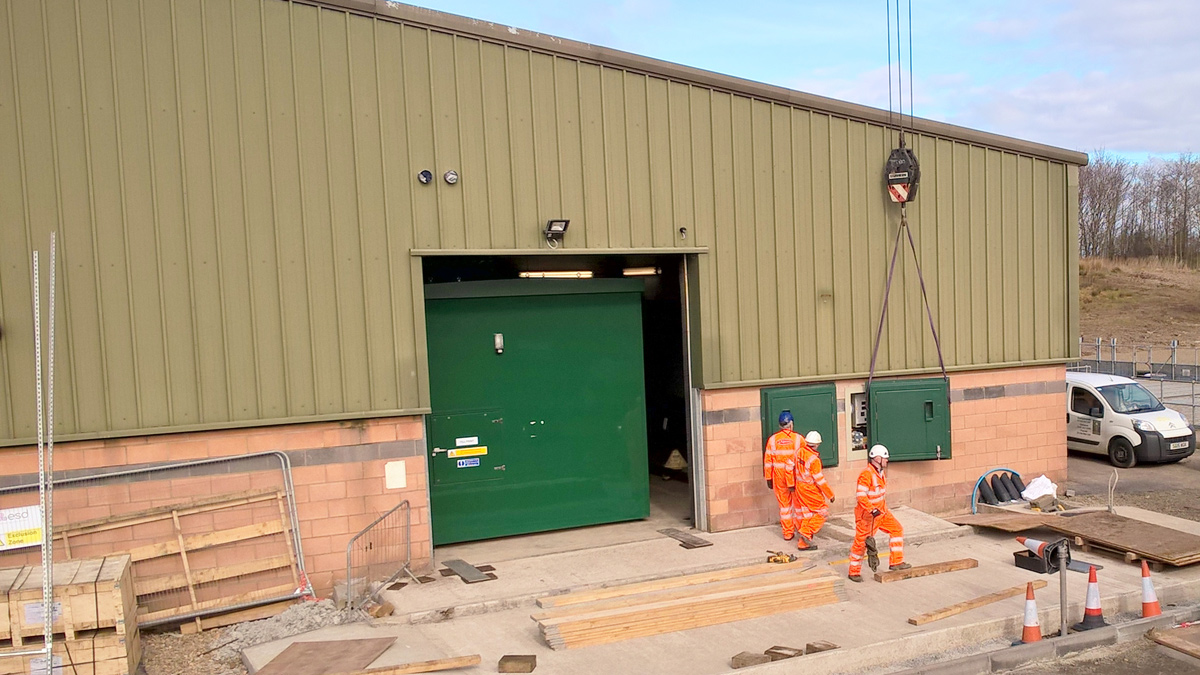
Installation of the chemical dosing kiosks at Ashgrove – Courtesy of ESD
Normally the distribution network would be fed with Bradan water as before. A sweetening flow is introduced from the Camphill main which is chloraminated to avoid potential taste and odour problems from mixing chlorinated Camphill water with chloraminated Bradan water. In the event of a treatment or distribution problem resulting in the loss of Bradan water, the flow from Camphill can be increased up to the design flow of 23 Ml/day and receive chloramination from the new chemical dosing system.
The scope of the work at Ashgrove to achieve the final solution:
- 1km of 350mm pipeline from Greenhead SR to Ashgrove CWT inlet pipe.
- 100m of 500mm inlet pipe from the Camphill main into Ashgrove SR incorporating hypochlorite and ammonium sulphate dosing.
- Refurbishment of Ashgrove Service Reservoir.
- Abandonment of Greenhead Service Reservoir and local mains cross connections.
In addition to the ammonium sulphate storage and dosing kiosk provided at Ashgrove, like those at Afton WTW and Bradan WTW, a sodium hypochlorite system was provided at Ashgrove. This was to trim the chlorine residual to the required level before chloramination. Like the ammonium sulphate dosing systems, the sodium hypochlorite system was manufactured and tested off-site. A mixer for dosing was installed in the new inlet pipe from Camphill WTW.
A new flow meter and chlorine and ammonia monitoring was introduced on the new inlet pipe to control the ammonia sulphate and sodium hypochlorite doses.
To bring the Ashgrove service reservoir back into service, a ne waterproof membrane was added to the roof, new security covers added, internal joints sealant replaced and internal corroded elements replaced.
To maintain the supplies at Greenhead once the SR was abandoned, the network was reinforced with some strategic cross connections.
Standard products used for the chemical dosing kiosks
The chemical dosing equipment; tanks, pumps, pipework, panels and cabling, were manufactured off site and pre-assembled into a kiosk. When ready, it was shipped to site and installed on a flat concrete slab with minimal site installation.
This had the advantage of:
- The adoption of the standard dosing kiosks meant that the kiosks could be made off-site and were not dependent on the civil works being ready.
- Factory tolerances and workmanship was of a higher quality and consistency to that achieved on site.
- Less waste.
- Independence from adverse weather and winter working.
- The factory environment can allow better safety than the construction site.
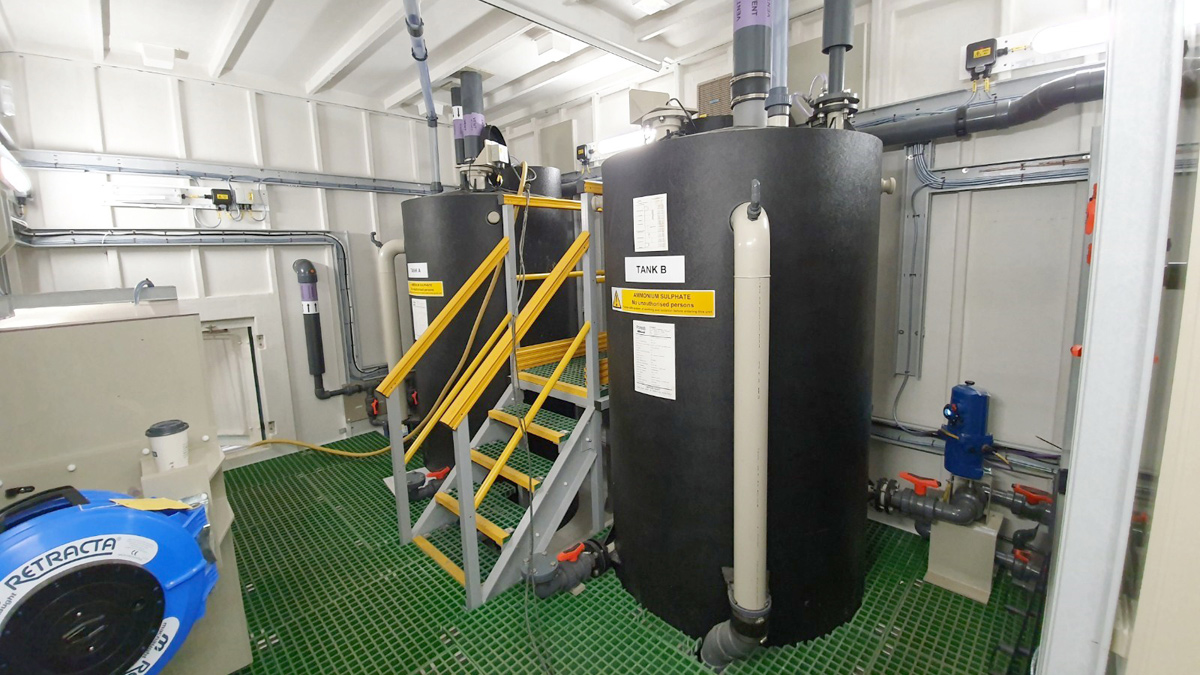
Chemical kiosk – Courtesy of ESD
Challenges
- Deep excavation in, and amongst, live services at Bradan to install the new static mixer and pipework connections on 30” ductile iron pipework.
- Difficult to locate services due to poor record drawings.
- Working on live mains, while maintaining supplies and quality of water.
- Laying the Greenhead to Ashgrove water main through a golf course.
Collaboration
The work has involved multiple connections to live mains. Throughout the works, water supplies have been maintained throughout. This has been achieved by regular commissioning and planning meetings to ensure all parties were aware of what was happening and thorough risk assessment processes.
Before work started on the section of the Ashgrove main through the golf course, the route was agreed with the golf club. Play was maintained throughout the works by moving tee-off positions and clearing the course of construction equipment at weekends when the course was busiest. The strategy of how this was going to be achieved was set out in a ‘Statement of Intent’ developed in detailed discussion between the golf club and ESD. This was signed up to by the golf club and ESD before work commenced.
Conclusion
The Bradan Water Quality Scheme has addressed the risk of THMs into several distribution areas fed by Bradan WTW and Afton. By strategically introducing chloramination it has maintained security of supply between the distribution systems without the risk of taste and odour issues. It has also provided additional similar security of supply resilience at Ashgrove CWT.
Work started on site in March 2017 and completion of all construction work is anticipated in November 2019.






